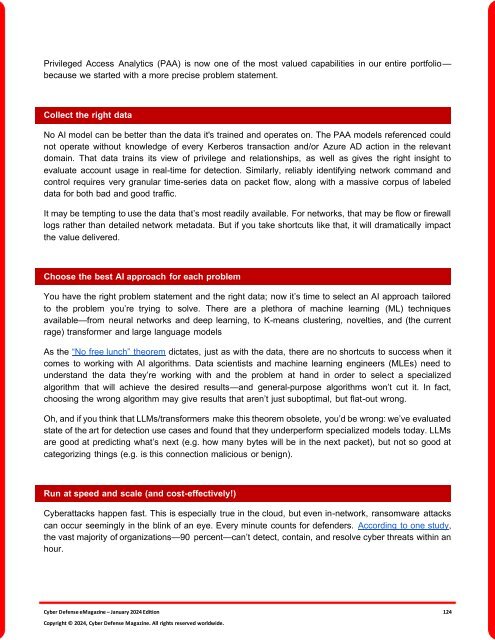The Cyber Defense eMagazine January Edition for 2024
Cyber Defense eMagazine January Edition for 2024 #CDM #CYBERDEFENSEMAG @CyberDefenseMag by @Miliefsky a world-renowned cyber security expert and the Publisher of Cyber Defense Magazine as part of the Cyber Defense Media Group as well as Yan Ross, Editor-in-Chief and many more writers, partners and supporters who make this an awesome publication! 201 page January Edition fully packed with some of our best content. Thank you all and to our readers! OSINT ROCKS! #CDM #CDMG #OSINT #CYBERSECURITY #INFOSEC #BEST #PRACTICES #TIPS #TECHNIQUES
Cyber Defense eMagazine January Edition for 2024 #CDM #CYBERDEFENSEMAG @CyberDefenseMag by @Miliefsky a world-renowned cyber security expert and the Publisher of Cyber Defense Magazine as part of the Cyber Defense Media Group as well as Yan Ross, Editor-in-Chief and many more writers, partners and supporters who make this an awesome publication! 201 page January Edition fully packed with some of our best content. Thank you all and to our readers! OSINT ROCKS! #CDM #CDMG #OSINT #CYBERSECURITY #INFOSEC #BEST #PRACTICES #TIPS #TECHNIQUES
Create successful ePaper yourself
Turn your PDF publications into a flip-book with our unique Google optimized e-Paper software.
Privileged Access Analytics (PAA) is now one of the most valued capabilities in our entire portfolio—<br />
because we started with a more precise problem statement.<br />
Collect the right data<br />
No AI model can be better than the data it's trained and operates on. <strong>The</strong> PAA models referenced could<br />
not operate without knowledge of every Kerberos transaction and/or Azure AD action in the relevant<br />
domain. That data trains its view of privilege and relationships, as well as gives the right insight to<br />
evaluate account usage in real-time <strong>for</strong> detection. Similarly, reliably identifying network command and<br />
control requires very granular time-series data on packet flow, along with a massive corpus of labeled<br />
data <strong>for</strong> both bad and good traffic.<br />
It may be tempting to use the data that’s most readily available. For networks, that may be flow or firewall<br />
logs rather than detailed network metadata. But if you take shortcuts like that, it will dramatically impact<br />
the value delivered.<br />
Choose the best AI approach <strong>for</strong> each problem<br />
You have the right problem statement and the right data; now it’s time to select an AI approach tailored<br />
to the problem you’re trying to solve. <strong>The</strong>re are a plethora of machine learning (ML) techniques<br />
available—from neural networks and deep learning, to K-means clustering, novelties, and (the current<br />
rage) trans<strong>for</strong>mer and large language models<br />
As the “No free lunch” theorem dictates, just as with the data, there are no shortcuts to success when it<br />
comes to working with AI algorithms. Data scientists and machine learning engineers (MLEs) need to<br />
understand the data they’re working with and the problem at hand in order to select a specialized<br />
algorithm that will achieve the desired results—and general-purpose algorithms won’t cut it. In fact,<br />
choosing the wrong algorithm may give results that aren’t just suboptimal, but flat-out wrong.<br />
Oh, and if you think that LLMs/trans<strong>for</strong>mers make this theorem obsolete, you’d be wrong: we’ve evaluated<br />
state of the art <strong>for</strong> detection use cases and found that they underper<strong>for</strong>m specialized models today. LLMs<br />
are good at predicting what’s next (e.g. how many bytes will be in the next packet), but not so good at<br />
categorizing things (e.g. is this connection malicious or benign).<br />
Run at speed and scale (and cost-effectively!)<br />
<strong>Cyber</strong>attacks happen fast. This is especially true in the cloud, but even in-network, ransomware attacks<br />
can occur seemingly in the blink of an eye. Every minute counts <strong>for</strong> defenders. According to one study,<br />
the vast majority of organizations—90 percent—can’t detect, contain, and resolve cyber threats within an<br />
hour.<br />
<strong>Cyber</strong> <strong>Defense</strong> <strong>eMagazine</strong> – <strong>January</strong> <strong>2024</strong> <strong>Edition</strong> 124<br />
Copyright © <strong>2024</strong>, <strong>Cyber</strong> <strong>Defense</strong> Magazine. All rights reserved worldwide.

















